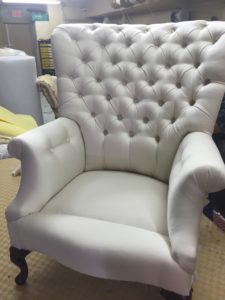


How to choose the right color for your furniture?

Curious to know if you can learn professional upholstery in a weekend? You’re not alone. High-level upholstery is an incredibly rewarding skill that offers the satisfaction of creating something custom with your own hands.
That said, it doesn’t come easy. Let’s take a closer look at what it takes to upholster like a pro.
Before we continue, we’d like to clarify the difference between professional-level and DIY upholstery.
DIY upholstery is easy if you’re working on a simple project that only requires a few tools. Professional upholstery, on the other hand, can be quite complex and includes intricate, one-of-a-kind pieces and large-scale custom work for high-end interiors. These types of projects require a variety of specialized tools and high-level techniques.
Unlike some fields that focus more on theory, professional upholstery demands a high level of hands-on skill. While there is plenty of knowledge-based learning involved, mastery of the physical techniques themselves is what truly defines this profession.
This is why becoming a professional upholsterer takes years of practice. There are countless types of furniture, materials, and projects, each with its own challenges and demands.
There are a variety of tools you need to master or at least have excellent proficiency in to upholster like a pro. While the list of tools is too exhaustive to put here, some standouts include:
There are different levels of teardown. Let’s say you have an old sofa that you love and want to keep. Now, if you’re a beginner, you might just replace the fabric and call it good.
By contrast, a professional upholsterer would (depending on the need) strip the furniture down to its frame, carefully removing the fabric, padding, and other internal components. Then, if necessary, the frame would be repaired or strengthened, and then new materials would be applied.
This is just one of many examples, and depending on your project (let’s say you’re working on an antique), a mistake can be costly. Naturally, serving diverse client needs and delivering satisfactory results across a wide range of projects takes longer than a weekend to learn.
Applying new upholstery at a professional level can be demanding, and demands can be unpredictable, ranging from re-tensioning webbing to expertly matching patterned fabrics and achieving flawless corners.
Often, the finer points take time and repeated practice to master.
Basic Tool Familiarity: Get comfortable using staple guns, tack hammers, fabric scissors, and other essential tools.
Simple Teardown: Learn how to carefully remove the old fabric and staples from a basic chair or small stool.
Measuring & Cutting: Practice measuring and cutting new fabric for your project.
Sewing: Try basic sewing techniques, such as straight stitching, and get introduced to using a walking foot.
Basic Assembly: Attach new fabric to a seat or cushion using simple techniques, focusing on getting the fabric smooth and secure.
For anything more complex, expect to invest much more time and practice.
We hope this article has clarified that while you can definitely get started and learn basic upholstery techniques in a weekend, professional upholstery takes much more time.
If you have a special piece of furniture that needs expert-quality craftsmanship, the best solution is to trust a professional.
At Redesign Upholstery, we offer professional upholstery services right here in Las Vegas. We’ve worked on everything from family furniture to custom pieces for Cirque du Soleil and other high-profile clients. Contact us today to discuss your upholstery project, and we’ll help you achieve the desired results.


